Waterfalls of the Black River
On Michigan's Upper Peninsula, a series of cascades tumble down to Lake Superior.
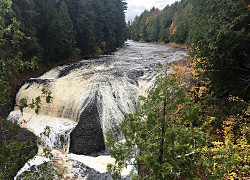
© Peter Ringham
On the western tip of Michigan's Upper Peninsula, the Black River is only one of more than 200 rivers that feed Lake Superior.
It punches far above its weight, however, in providing waterfalls: Five of them in one short stretch draw visitors year-round.
Part of the million-acre Ottawa National Forest, the Black River is so scenic it's part of two national trails — the North Country Trail for hiking and the Black River National Forest Scenic Byway for driving.
The waterfalls were the draw for me and some friends one March. Coursing over slabs of volcanic rock, they punctuate the last three miles of the river before it flows into Lake Superior.
In winter, people can get close and even clamber right into the river gorge to see them.
My friends and I stayed across from Great Conglomerate Falls at Bear Track Cabins, in an old logging-camp bunkhouse and a 1938 chinked-timber former tavern that once catered to loggers and fishermen.
Now it's a roomy lodge, with a wood stove, a piano and decor that includes snowshoes, a stag head, a vintage radio and twinkle lights wrapped around thick ceiling beams.
Once, the scenic byway that passes its front door was a wagon road, connecting Lake Superior to the iron mines on the Gogebic Range. A fishing village formed around the river's mouth, and 200 people once lived around Black River Harbor.
Today, it's a recreation area operated by the U.S. Forest Service and frequented by boaters and campers. The most spectacular waterfall is the last, Rainbow Falls, less than a mile away.
From the road, we climbed down a long flight of wooden steps and stood staring at its furious waters, pounding over a 40-foot ledge and into a frothing pool.
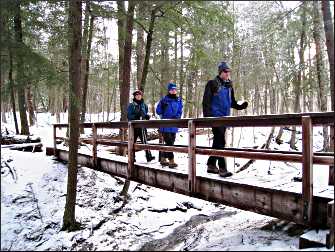
© Beth Gauper
Temperatures had risen, and mist drifted along the cliff face, shaping draped snow into femurs and shin bones. On the rocks, plumes of spray had created a patch of cauliflower snow.
Aside from the froth, dyed by hemlock bark, the whole world was a grimy white. Then a few rays of sun broke through the clouds, and we saw the shimmer of a rainbow in the mist.
From the falls, we hiked through hemlock forest, following the blue diamonds of the North Country National Scenic Trail toward Lake Superior.
A suspension bridge crossed the river, and we climbed to an overlook, where we could see the setting sun reflected in pools of golden water.
People were poking around the little harbor, wandering from the marina dock out to the big beach on Lake Superior.
From there, it's just five miles over wind-packed snow to four picturesque waterfalls around the mouth of the Presque Isle River, in Porcupine Mountains Wilderness State Park.
It's a fast ski in colder temperatures. But when we were there, the snow was too soft to allow the trip.
The next day, we strapped on snowshoes and headed into the forest across the road. Gorge Falls squeezes through a narrows lined with cedar, and water was spurting over the 20-foot drop like the ball in a pinball machine, hitting first one side, then the other.
Blue-tinted icicles had sprouted on the cliffside, and the foam at the bottom of the falls was frosted with tannins and heaving like a waterbed. The roar of water filled the narrow gorge.
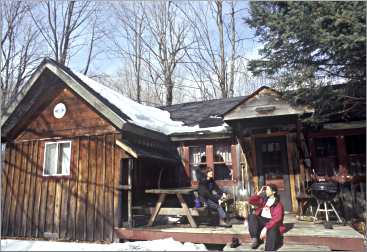
© Beth Gauper
Then the roar stopped. We waited, but all we heard was a muffled whoosh. The water no longer was crashing; ice had given way and allowed it to flow straight into a channel under the frozen surface.
In winter, ice shifts as quickly as a mirage. From Gorge Falls, we hiked upstream to Potawatomi, which is almost as tall as Rainbow. It had split into two torrents, one shooting under a snow bridge and one dropping straight into a hole, from which vapor floated up like a bridal veil hanging on breeze.
At Great Conglomerate Falls, the river had split, bumping down three steps and around a dimpled patch of snow. Under our feet, the snow had turned slushy; it seemed as if the whole forest was leaking water.
Most of the group decided to head to deeper snow inland, at Big Powderhorn ski hill and the ABR cross-country trails.
We decided to spend a little more time on the North Country Trail, near the back side of Copper Peak, the only ski-flying hill outside of Europe.
Algonquin Falls is more like a rapids, but we walked there anyway.
The trail is popular with deer, too, and we frightened one away as we made our way through the hemlock and cedar.
Once at the river bank, we stood watching thick shingles of honey-colored ice butting their way down river, like tectonic plates bobbed up from the depths.
There's not much to see along the Black River except water and rock. But the view changes every minute.
Trip Tips: Waterfalls of the Black River on the Upper Peninsula
Getting there: It's a 4½-hour drive from the Twin Cities, 5 hours from Madison and nearly 6 hours from Milwaukee.
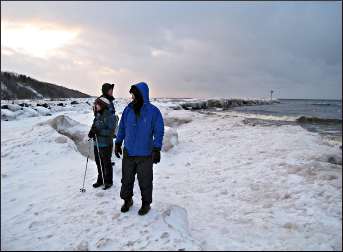
© Beth Gauper
The Upper Peninsula has all but one of Michigan's waterfalls, more than 300 of them.
When to go: The waterfalls are spectacular during spring runoff, in April and May, and the last two weeks of May are peak for spotting spring ephemerals in the woods.
In the heat of summer, the Black River Recreation Area is very popular, especially the sand swimming beach. In fall, the forest colors are among the best in the region.
Accommodations: Bear Track Cabins, on Black River Road a mile and a half from Lake Superior, has three cabins. The two-bedroom lodge has three double beds and two twins. The Ojibwe cabin has one double and three twins. The log cabin has two doubles.
Furnishings are old-fashioned but comfortable; cabins have TVs, VCRs and CD players. There's a wood-fired sauna, and the proprietor rents snowshoes.
In the woods behind the resort, there are 7.5 miles of trails that are groomed but not tracked. Call 906-932-2144.
Black River Lodge also is on Black River Road, eight miles north of Bessemer. Rooms, suites and condos include a continental breakfast. There's a pool and hot tub, 906-932-3857.
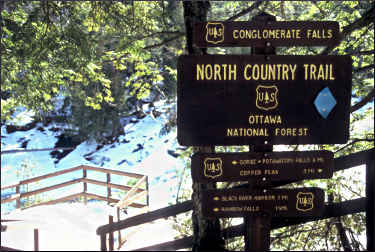
© Beth Gauper
The Big Powderhorn Lodging Association offers many vacation rentals.
In Bessemer, the Bluffs Inn is on U.S. 2. Call 906-667-0311.
Camping: At Black River Harbor, there's a beach, picnic area, marina and an Ottawa National Forest campground in which sites can be reserved.
Dining: Black River Valley Pub and Grub serves burgers, sandwiches, soup, salad and pizza on Black River Road.
Copper Peak: For a stupendous view from the top of this ski-flying hill, you can ride a chairlift to the crest of a volcanic outcrop, ride 18 stories on an elevator to an observation deck, then climb eight stories to the top starting gate.
Alpine skiing: Off U.S. 2, Big Powderhorn has sunny and open. Just a couple miles farther on U.S. 2, Indianhead has a sunny chalet atop its mountain and nice intermediate runs.
For more, see Ski the UP.
Cross-country skiing: Two Ironwood trail systems are mecca for skiers from less snow-blessed areas.
For more, see Ironwood the reliable.
Information: Upper Peninsula tourism, 906-774-5480. Ironwood tourism.